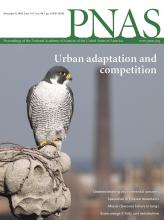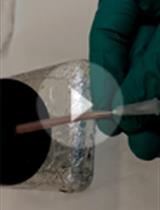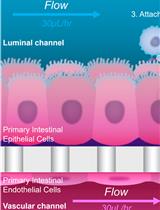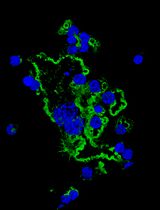- EN - English
- CN - 中文
Adhesive and Cohesive Peel Force Measurement of Human Airway Mucus
人气道粘液的黏附力和粘结剥离力测定
发布: 2019年07月05日第9卷第13期 DOI: 10.21769/BioProtoc.3287 浏览次数: 6089
评审: Andrea PuharSourav S PatnaikSongjie Cai
Abstract
In health, the high-speed airflow associated with cough represents a vital backup mechanism for clearing accumulated mucus from our airways. However, alterations in the mucus layer in cystic fibrosis (CF) and chronic obstructive pulmonary disease (COPD) leads to the mucus layer adhered to the airway surfaces, representing the nidus of chronic lung infection. To understand what is different about diseased mucus and why cough clearance is defective, there is a need for techniques to quantify the strength of the interactions limiting the ability of airflow to strip mucus from the airway surface (i.e., adhesive strength) or tear mucus apart (i.e., cohesive strength). To overcome the issues with measuring these properties in a soft (i.e., low elastic modulus) mucus layer, we present here novel peel-testing technologies capable of quantifying the mucus adhesive strength on cultured airway cells and cohesive strength of excised mucus samples. While this protocol focuses on measurements of airway mucus, this approach can easily be adapted to measuring adhesive/cohesive properties of other soft biological materials.
Keywords: Lung disease (肺部疾病)Background
The healthy airway mucosal barrier represents a powerful innate immune system designed to protect the pulmonary surfaces from the persistent onslaught of inhaled infectious and noxious substances. During times of airway infection, high-velocity airflow (i.e., cough) represents an effective backup mechanism to clear accumulated mucus. However, abnormalities in mucus properties, which characterize several airway diseases, including cystic fibrosis (CF), chronic obstructive pulmonary disease (COPD), and asthma, lead to a reduction in airflow-mediated cough clearance (Button et al., 2016).
To fully elucidate why such mucus fails to clear with cough-induced shear forces, it is necessary to understand the biophysical interactions between airway mucus and airway surfaces. The high-speed airflow associated with cough can remove mucus from airway surfaces through at least two distinct mechanisms: 1) “disadhesion”, whereupon the mucus layer is physically detached from the underlying airway surface as a result of overcoming the “adhesive” interactions between mucus and the airway cell surface; and 2) “tearing”, where chunks of mucus are broken off adherent mucus masses as a result of overcoming mucus-mucus cohesive bonds and interactions.
There are various material science approaches, such as “peel” testers, to quantify the strength of the interaction between one material and another. To initiate a test with these devices, the user “connects” one end of the test material to a movable arm, which then measures the force required to peel the material off a stationary surface. However, the challenge with measuring the mucus adhesive and cohesive strength is that mucus is a fragile material with elastic modulus typically < 10 Pa (Hill et al., 2014) therefore making it impossible to directly connect to a peel device. Furthermore, to measure adhesion strength of mucus to the airway epithelial surface, it is necessary to perform studies in a suitable environment to prevent evaporation of the thin (< 100 μm) mucus layer (Matsui et al., 1998). To overcome these limitations, we have developed a novel peel force technique to quantify both the adhesive and cohesive strengths of airway mucus. Key to this technique, described in detail in this protocol, is the use of a mucus-binding mesh which allows for the peeling of the mucus layer off of the airway surface (i.e., adhesive strength) or another a fixed mucus-binding mesh (i.e., cohesive strength) (Figure 1A). The mucus binding mesh utilized in this protocol is made from a standard laboratory cellulose wipe (Kimwipe). These mucus-binding meshes are very strong, flexible, and as anyone who has blown their nose into tissue paper knows, binds very strongly to mucus. Finally, extensive testing has shown that these meshes are not cytotoxic and do not damage the airway epithelial cells that they are laid upon (Button et al., 2018). Below, we show the construction and application of the mucus-binding mesh-based approach to measure mucus adhesion and cohesion, when connected to a peel test device (Figure 1B).
Using the protocol, we have previously shown that both adhesive and cohesive properties of mucus are sensitive to changes in mucus concentration associated with CF and COPD (Button et al., 2018). In addition to understanding the role of diseased mucus on these biophysical properties, the approach described here can also be useful for identifying/screening therapies designed to improve mucus clearance in subjects with muco-obstructive diseases. Additionally, these measurements can be performed on human-derived mucus samples (i.e., expectorated sputum and isolated airway mucus), potentially valuable for assessment of therapeutic intervention and disease progression. Indeed, we have utilized these techniques to assess the effect of several agents (i.e., mucolytics) which can reduce the adhesive and cohesive strength of CF/COPD mucus (Button et al., 2018). Finally, while this protocol is written to describe the measurement of airway mucus properties, this approach should easily be adapted to measuring adhesive/cohesive properties of other mucus samples (GI, cervical, etc.) as well as other fragile biological or synthetic materials.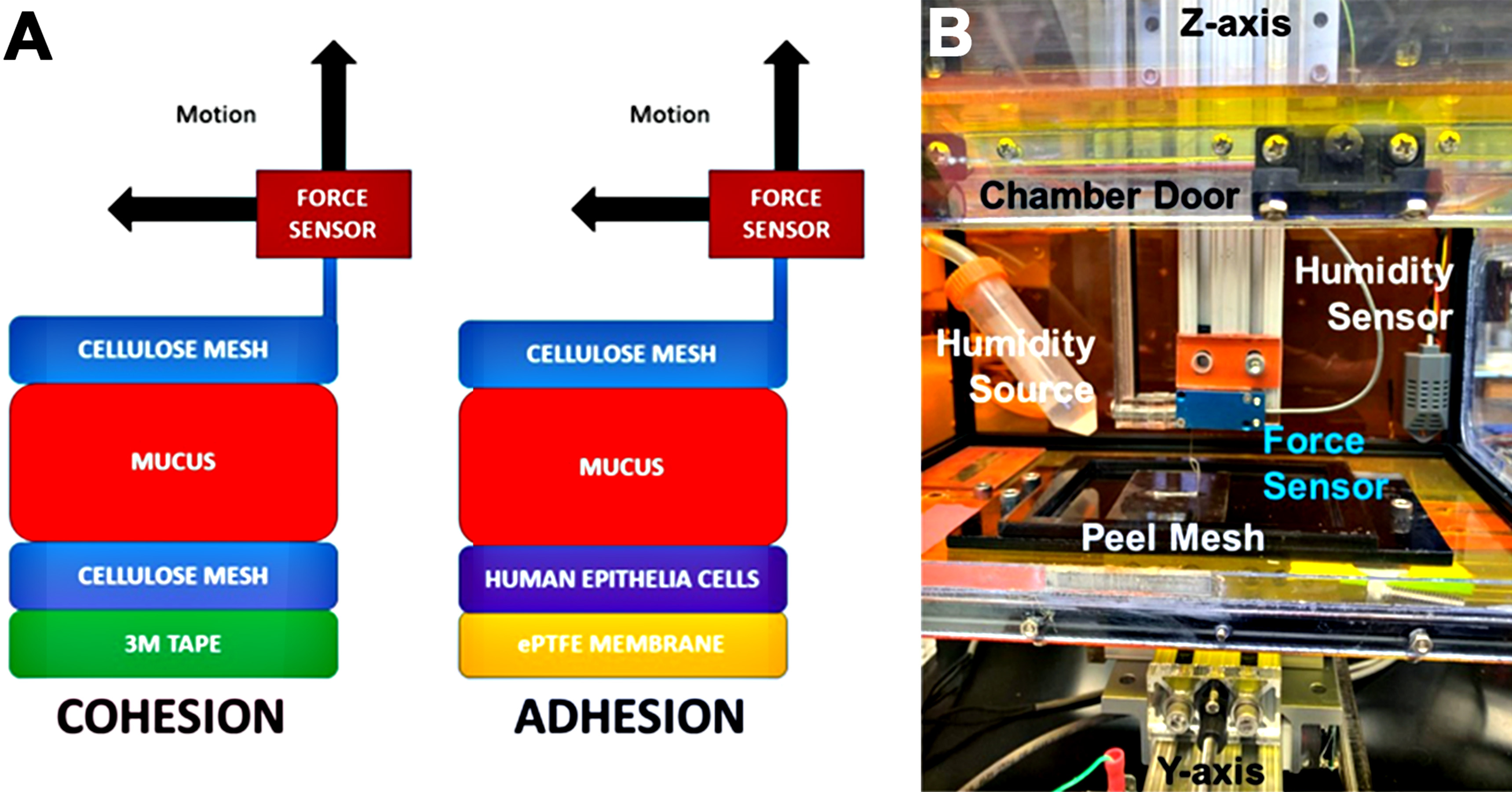
Figure 1. Overview of the adhesion and cohesion technique. A. Assembly diagram of the systems for measuring mucus cohesion (left) and adhesion (right). B. Picture of the actual peel test device described in this protocol.
Materials and Reagents
- Kimwipe cellulose wipe (Kimberly Clark, catalog number: 34256)
- Sylgard 184 (Dow Corning, catalog number: 4019862)
- Magnetic strips (McMaster Carr, catalog number: 5699K68)
- Glass plates (McMaster Carr, catalog number: 8476k23)
- Polyethylene double-sided medical adhesive (3M, catalog number: 1552)
- Spin concentrator (Ultra 10K) (Amicon, catalog number: UFC901024)
- 50 ml conical tube (Corning, catalog number: 352070)
- 6-well plate (Corning Costar, catalog number: 3516)
- Well-differentiated human airway epithelial cultures (Fulcher et al., 2005)
- Airway mucus samples (Button et al., 2012)
- Hexane (Sigma-Aldrich, catalog number: 293253)
- 1x Phosphate buffered saline (PBS) containing calcium and magnesium (Gibco, catalog number:14190144)
- 100% Isopropanol (Fisher Scientific, catalog number: A416-1)
- 30-mm Millicell culture inserts, hydrophilic PTFE (Millipore, catalog number: PICM03050)
- Air-liquid interface (ALI) cell culture media (Randell et al., 2011) (or commercially available from Stemcell Technologies, catalog number: 05001)
Equipment
- Custom-designed 3-axis peel-tester (see text below)
- Aluminum extrusions (80/20 Incorporated, catalog number: 1515-LS)
- Linear bearings (80/20 Incorporated, catalog number: 6415)
- Precision leadscrews (McMaster-Carr, catalog number: 6350K689)
- DC servo Motors (Rhino, catalog number: RMCS-22)
- Magnetic position sensor (AMS, catalog number: AS5311)
- Microcontroller running Labview Interface for Arduino (Arduino, UNO)
- Force sensor (Transducer Technologies, GSO family) (model depends on sensitivity required)
- Acrylic box (McMaster-Carr, catalog number: 8774K12)
- Stable Micro Systems TA.XT2i Texture Analyzer (in lieu of a custom peel-tester)
- CO2 laser cutter (Full Spectrum Laser/Epilog/etc.) (optional, see below)
- UV sterilizer (Thermo)
- Ultrasonic humidifier (Holmes, catalog number: HM500TG1)
- Humidity sensor and controller (Image, catalog number: WH8040)
- Positive-displacement pipetters (Gilson)
- Accusprayer with 2.0-micron head (3M, catalog number: 166609)
- High-humidity tissue culture incubator (Nuaire, catalog number: NU-4850)
Software
- National Instruments Labview motor control and data acquisition software (available upon request)
- Microsoft Excel (or Equivalent)
Procedure
文章信息
版权信息
© 2019 The Authors; exclusive licensee Bio-protocol LLC.
如何引用
Goodell, H. P., Shenoy, S. K., Shenkute, N. T., Lackey, E., Dennis, R. G. and Button, B. (2019). Adhesive and Cohesive Peel Force Measurement of Human Airway Mucus. Bio-protocol 9(13): e3287. DOI: 10.21769/BioProtoc.3287.
分类
生物化学 > 蛋白质 > 稳定性
细胞生物学 > 基于细胞的分析方法 > 胞外微环境
您对这篇实验方法有问题吗?
在此处发布您的问题,我们将邀请本文作者来回答。同时,我们会将您的问题发布到Bio-protocol Exchange,以便寻求社区成员的帮助。
提问指南
+ 问题描述
写下详细的问题描述,包括所有有助于他人回答您问题的信息(例如实验过程、条件和相关图像等)。
Share
Bluesky
X
Copy link


